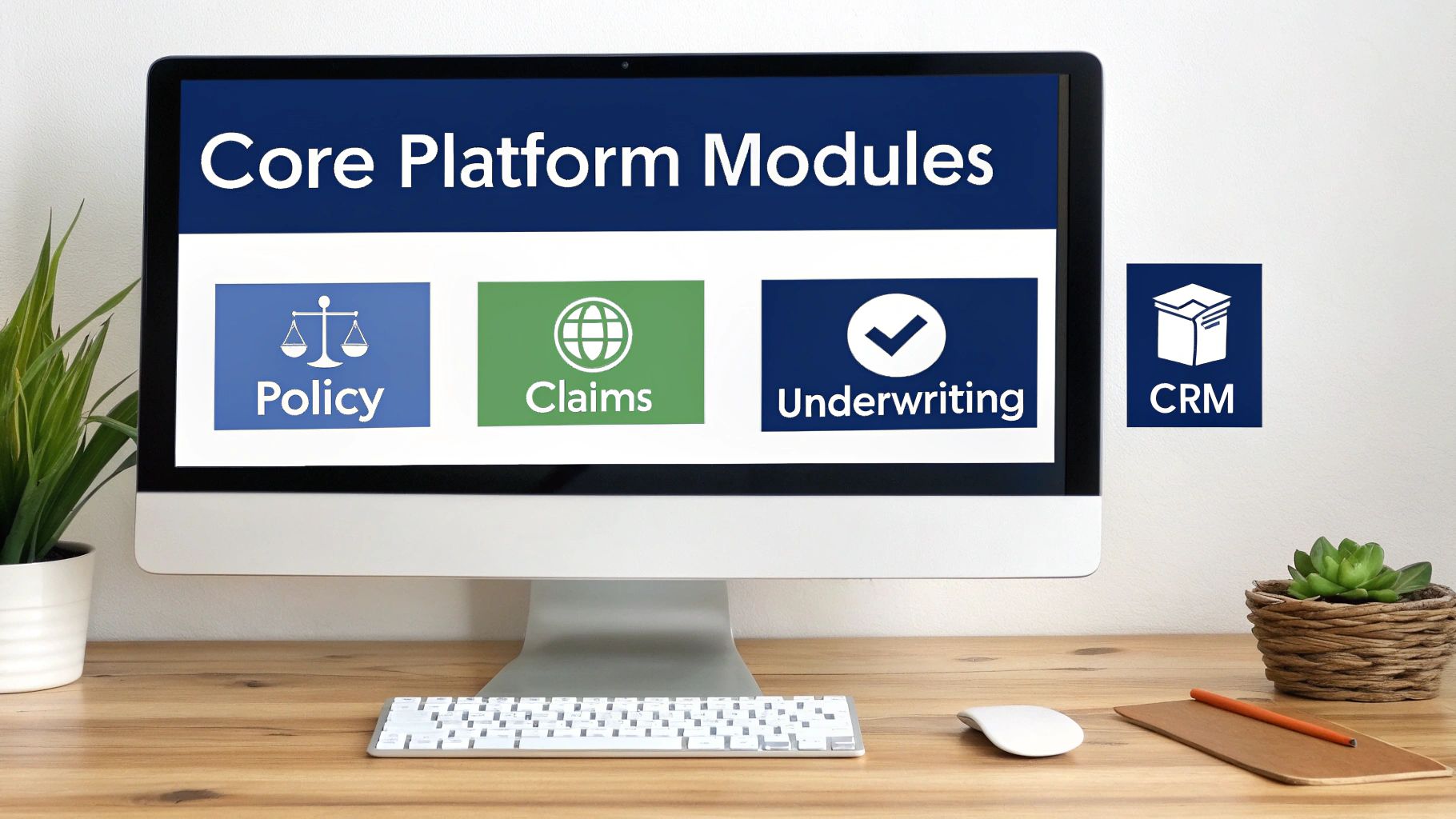Generic insurance software can get you started, but it’s like trying to run a marathon in a pair of dress shoes. It just wasn't built for the specific challenges and pressures modern insurers face every single day. As the industry gets more competitive and customers demand more, these one-size-fits-all platforms start showing their cracks, often creating more headaches than they solve.
The Limits of One-Size-Fits-All Platforms
The insurance world isn't a monolith; what works for a large auto insurer is completely different from what a niche commercial property firm needs. Off-the-shelf solutions are designed for the "average" company, which means they rarely have the specialised tools needed to handle unique risk models, navigate complex local regulations, or deliver the hyper-personalised service that wins customers. To get a real sense of why generic software is falling behind, it helps in understanding what Insurtech is and the new standards it's setting.
This lack of flexibility forces insurers into awkward, clunky workarounds. You end up trying to bend your proven business processes to fit the software's rigid structure, instead of the software supporting how you actually work. This usually leads to a messy patchwork of different systems, endless manual data entry, and a frustrating experience for everyone involved – from your underwriters to your policyholders. We've explored this exact problem in detail in our comparison of custom software vs off-the-shelf software.
Evolving Demands and Competitive Pressures
Today’s customers expect the same smooth, digital experience from their insurer that they get from their favourite online store or banking app. They want quick quotes, simple online claims, and communication that feels personal, not generic. Off-the-shelf systems really struggle to provide this level of service, leaving the door wide open for newer, more agile competitors to steal market share. These disruptors are often built from the ground up on flexible platforms, letting them innovate much faster.

This trend is especially clear in places with unique market challenges. Take California, for example, where a mix of increasing natural disaster risks and specific state regulations makes highly adaptable software a necessity. Between 2021 and 2025, the number of California insurance companies that adopted customised digital platforms for managing policies and claims jumped by 32%. The result? They managed to cut their average claims processing times by 15%, a clear win for efficiency.
The Strategic Imperative for Customisation
At the end of the day, sticking with outdated, generic software isn't just inefficient; it’s a risky business strategy. Moving to a tailored insurance software solution isn't just about a technology upgrade; it’s a fundamental move to ensure your business can compete and grow.
A custom-built platform gives you the power to:
-
Automate Complex Workflows: You can design processes that perfectly mirror your unique way of doing business.
-
Manage Niche Risks: It allows you to create highly specific underwriting rules and risk assessment models that off-the-shelf software can't handle.
-
Deliver Superior Customer Experiences: You can build personalised customer journeys that foster loyalty and keep people coming back.
Investing in software built specifically for your needs creates a strong foundation for long-term agility and a real competitive edge. As we’ll dig into next, it's the core components of these custom systems that truly unlock these powerful advantages.
The Core Components of a Custom Insurance Platform
It's helpful to think of a custom insurance platform not just as a piece of software, but as the central nervous system for your entire business. It's a living ecosystem where every part has a specific job, but they all communicate seamlessly to create one powerful, unified system. This is the opposite of generic software, which often forces you to cram your unique processes into a box that doesn't quite fit.
At its core, a well-designed custom platform is modular. This simply means it's built from distinct, interconnected components, with each one perfected for a core business function. This structure gives you incredible flexibility, letting you update, refine, and expand individual parts of your operation without having to tear down and rebuild the whole thing.

Policy Administration System (PAS)
The Policy Administration System, or PAS, is the absolute engine room of any insurance company. It’s where the entire lifecycle of a policy lives and breathes, from the first quote and binding, right through to endorsements, renewals, and eventually, cancellation. Think of it as the official system of record for every single policy you write.
Sure, an off-the-shelf PAS can handle the basics, but customisation is where you unlock real competitive power. Imagine a PAS built specifically for your niche, whether that’s insuring high-risk commercial properties or providing specialised liability coverage. It can automate the complex rating algorithms that reflect your unique underwriting philosophy, handle non-standard policy terms without a hitch, and generate compliant documents for any region you operate in.
A tailored PAS isn't just about keeping records straight. It becomes a strategic weapon for product innovation, giving you the agility to launch new, complex insurance products far faster than competitors stuck with rigid, pre-built systems.
This kind of precise customisation ensures your core operational workflow isn’t just supported by your technology; it’s actively sharpened by it.
Claims Management Module
The claims module is where the rubber meets the road; it’s where your promise to the policyholder is truly tested. A smooth, fair, and transparent claims process is absolutely critical for keeping customers happy and maintaining financial stability. Generic claims systems often create friction, bogged down by manual data entry and clunky communication that leaves both adjusters and claimants frustrated.
Building your own claims module means you can design a workflow that perfectly mirrors your claims-handling philosophy. For instance, you could integrate automated fraud detection algorithms trained on your own historical data, allowing them to spot suspicious patterns that a generic system would almost certainly miss. You can also fully automate the First Notice of Loss (FNOL) intake, intelligently assign claims based on an adjuster’s specific expertise and current workload, and connect directly with third-party vendors like repair shops or medical assessors.
The result is a claims process that’s faster, more accurate, and less expensive to run.
Underwriting and Risk Assessment Engines
Underwriting is both an art and a science, and a powerful underwriting engine is what separates a profitable book of business from a house of cards. Standard software offers basic underwriting rules, but it can’t possibly capture the nuanced expertise and proprietary risk models that give you an edge in the market.
Tailored insurance software solutions let you hard-code your unique underwriting DNA directly into your systems. This means you can:
-
Automate Data Enrichment: The system can instantly pull data from third-party sources – like property records, driving histories, or weather data – to give underwriters a complete risk profile without hours of manual research.
-
Codify Complex Rules: You can build sophisticated, multi-layered rules that perfectly reflect your risk appetite, automatically flagging applications for senior review or declining those that fall outside your set parameters.
-
Integrate Predictive Analytics: By weaving in machine learning models, your underwriting engine can analyse historical data to more accurately predict future losses, leading to smarter, more precise pricing.
This kind of functional architecture is essential for building a resilient and profitable platform. For anyone interested in the technical nuts and bolts, learning about different enterprise application architecture patterns offers a much deeper look into how these sophisticated systems are engineered.
Customer Relationship Management (CRM)
In today’s market, insurance is just as much about relationships as it is about risk. A purpose-built CRM gives your team a true 360-degree view of every policyholder. It pulls every interaction, from initial quote requests and policy changes to claims history and service calls, into a single, easy-to-understand dashboard.
Unlike a generic sales CRM, an insurance-specific one is built to track policies, key renewal dates, and natural cross-sell opportunities. It gives your agents and service reps the information they need to offer proactive, genuinely helpful advice, which is the key to building loyalty and increasing the lifetime value of each customer.
Unlocking Strategic Business Advantages
Looking past a simple list of features, the real power of a custom system is the impact it has on your business day-to-day. Investing in tailored insurance software isn't just a tech upgrade; it’s a strategic move that delivers real, competitive advantages across the board. It becomes the engine that drives your growth, efficiency, and long-term stability.
These platforms aren’t built to just copy what you're already doing. They're designed to fundamentally improve your processes, creating a ripple effect that strengthens your bottom line and builds better customer relationships.
Driving a New Level of Operational Efficiency
One of the first things you'll notice is a massive leap in operational efficiency. Off-the-shelf software often shoehorns your team into clunky manual workarounds and mind-numbing data entry, pulling them away from high-value work.
A custom platform gets rid of those tedious tasks through automation. This frees up your experts to do what they do best – underwriting complex risks, handling sensitive claims, and nurturing client relationships. Imagine a system that automatically pulls and verifies data from different sources, cutting manual entry errors by over 90% in some cases. That kind of automation leads directly to faster processing and lower operating costs.
Gaining Deeper Insights with Advanced Analytics
Standard software gives you basic reports. A bespoke solution, on the other hand, delivers something much more powerful: deep, actionable insights. By building advanced analytics and business intelligence tools right into your core platform, you can turn your raw data into your most valuable strategic asset.
This is what enables smarter, data-driven decisions where it counts most:
-
Smarter Underwriting: You can dig into historical data to spot subtle risk patterns and pricing opportunities that generic models would completely overlook.
-
Superior Risk Management: Proactively pinpoint risk concentrations in your portfolio and simulate the impact of market shifts or major events.
-
Enhanced Fraud Detection: Use machine learning algorithms trained specifically on your claims data to flag suspicious activity with incredible accuracy.
These capabilities let you price policies more accurately and manage risk more effectively, which directly boosts profitability. Knowing how to use these tools is crucial, which is why we've put together a guide exploring how business intelligence in insurance is uncovered.
Achieving Long-Term Scalability and Agility
Your business isn't standing still, so why should your technology? A major benefit of custom software is its built-in scalability. The system is designed with your future in mind, letting you add new products, expand into new markets, or adopt new technologies without being handcuffed by a vendor's rigid development schedule.
A scalable architecture ensures your platform evolves with your business, not against it. This future-proofs your investment, turning your technology from a cost centre into a platform for continuous innovation and adaptation.
This kind of agility is essential for staying ahead of the curve and reacting quickly to whatever the market throws at you.
Ensuring Seamless Regulatory Compliance
Keeping up with the complicated and constantly shifting web of insurance regulations is a huge undertaking. Custom software can offer some much-needed peace of mind by baking compliance right into your daily workflows. The system can be designed from the start to follow specific regional rules, automatically generate compliance reports, and keep perfect audit trails.
This proactive approach dramatically lowers the risk of expensive fines and the reputational fallout that comes with non-compliance.
Your Implementation Roadmap from Concept to Launch
Bringing a custom software solution to life is a journey, not a sprint. A clear, well-thought-out roadmap is what turns a complex project into a series of manageable, transparent phases. It's the only way to ensure the final product isn't just a technical marvel but a tool that’s perfectly tuned to your business goals from day one.
Trying to build custom software without a solid plan is a recipe for disaster – think scope creep, blown budgets, and a final product that just doesn't hit the mark. A structured implementation process, on the other hand, is how you transform a great idea into a high-value asset for your company. This methodical approach is at the very heart of our comprehensive software development services.
Phase 1: Discovery and Strategic Planning
This first stage is, without a doubt, the most important part of the entire project. Before anyone even thinks about writing a line of code, we need to get under the hood of your business. We spend this time understanding your specific challenges, your day-to-day workflows, and your biggest strategic goals. It’s all about asking the right questions to get a crystal-clear picture of what success looks like for you.
We'll work side-by-side with your key people, from the underwriters and claims adjusters on the front lines to the leadership team, to map out every single requirement. This deep collaboration guarantees everyone is on the same page and establishes a solid vision for the tailored insurance software solutions we’ll build together.
The main goals for this phase are:
-
A Detailed Project Scope: We’ll produce a comprehensive document that outlines all features, functions, and technical specs. No guesswork.
-
Technology Stack Selection: Together, we'll choose the right programming languages, frameworks, and cloud infrastructure to ensure top-notch performance and future scalability.
-
A Clear Project Timeline: We'll set realistic milestones and deadlines for each stage of development, so you always know what’s happening and when.
-
Resource Allocation: We’ll define the team structure and make sure the right people and resources are assigned to make your project a success.
This process is all about translating your high-level strategic goals into real, tangible software features. We move from broad objectives to specific, actionable steps. The infographic below shows how custom solutions create major advantages like better efficiency, data-driven decision-making, and sustainable growth.

As you can see, each stage of development builds on the last, leading to a powerful tool that improves every corner of your operation.
Phase 2: Design and Prototyping
With a rock-solid plan in place, we shift our focus to the user experience (UX) and user interface (UI) design. This is where we create the look and feel of your new platform, making sure it’s intuitive, efficient, and genuinely easy for your team to pick up and use.
We build out wireframes and interactive prototypes so you can get a real feel for the software early on. This approach lets your team give feedback and suggest tweaks before we dive into the heavy lifting of development, which saves a huge amount of time and money down the road.
A well-designed interface isn't just about looking good; it's about slashing training time, reducing user errors, and boosting productivity. The goal is to create a seamless experience that empowers your staff, not frustrates them.
Phase 3: Agile Development and Iteration
This is where your vision really starts to become a reality. We use an agile development methodology, which means we break the project into smaller, manageable cycles called "sprints." This keeps the process flexible and allows for continuous improvement as we build.
At the end of each sprint, we deliver a working piece of the software for your team to review. This back-and-forth process keeps you in the loop every step of the way, giving you regular chances to test features and confirm the project is moving in exactly the right direction. It's a foundational part of effective insurance software development, as we explored in our end-to-end software development solutions guide.
Phase 4: Rigorous Testing and Quality Assurance
Quality is non-negotiable. Before the software ever goes live, it goes through a battery of tests to hunt down and fix any bugs, performance bottlenecks, or security weak spots. Our Quality Assurance (QA) team runs a whole suite of tests to make sure the platform is tough, reliable, and secure.
This critical phase ensures the final product doesn't just meet your functional checklist but also performs flawlessly under the pressures of the real world. Of course, our work doesn't stop at launch. The team at Cleffex is committed to providing ongoing support. You can learn more about us and our focus on building long-term partnerships.
How to Choose the Right Development Partner
Picking a technology partner is easily one of the most critical decisions you'll make. The success of your custom software project isn't just about the code; it’s about the expertise, communication, and collaborative spirit of the team you bring on board. This isn't a simple vendor relationship – you're choosing a partner who will essentially become an extension of your own team.
Finding the right fit means searching for a unique blend of technical prowess, deep industry knowledge, and a cultural vibe that clicks with yours. A great partner doesn't just write code. They get inside your business challenges and work with you to build a solution that actually solves them.
Evaluating Technical Expertise and Industry Experience
First things first: your potential partner needs a proven track record in the insurtech space. Building software for the insurance industry is a different beast entirely from a standard business app. It demands a sophisticated understanding of complex financial regulations, strict data security protocols, and the intricate workflows of policy admin and claims processing.
Look for a team with real, demonstrable experience. Ask them to walk you through case studies or show you examples of previous projects where they have delivered tailored insurance software solutions. Their portfolio should be full of modern cloud technologies, AI, and data analytics – these are the tools that will give your platform a real competitive edge.
Assessing Engagement Models and Collaboration
It's also crucial to understand how a potential partner organises their teams and manages projects. Before you dive in, it’s worth your time understanding staff augmentation vs. consulting models. Knowing the difference will help you figure out the best approach for your own internal resources and project goals.
Beyond the formal model, you need to zero in on the 'soft skills' that make a partnership truly successful:
-
Transparent Communication: They should have a clear, established process for regular updates, feedback sessions, and progress reports. You should never be left in the dark, wondering what's happening.
-
Collaborative Spirit: You're looking for a team that actively wants your input and treats the project like a true collaboration. They need to listen, adapt, and brainstorm with you to find the best path forward.
-
A Commitment to Post-Launch Support: The relationship can't just end the day your software goes live. A reliable partner will offer ongoing support, maintenance, and a clear plan for future enhancements.
Choosing a partner is about finding a team that is genuinely invested in your success. Their commitment has to go beyond the initial build, ensuring your platform stays secure, effective, and aligned with your business goals as they change over time.
Key Questions to Ask Potential Vendors
To properly vet potential partners, you have to ask the right questions. This helps you get past the sales pitch and see their real capabilities and how they operate. As we explored in our end-to-end software development solutions guide, a structured process is your best friend here.
Here is a practical checklist to guide your conversations:
-
Can you share specific examples of your experience in insurance software development? This directly tests their industry knowledge.
-
How do you ensure compliance with financial and data privacy regulations? This is a non-negotiable for any software touching sensitive policyholder information.
-
What is your approach to project management and communication? This tells you how they keep clients in the loop and projects on schedule.
-
How do you handle scope changes or unexpected roadblocks during development? Their answer will reveal their flexibility and problem-solving skills.
-
What does your post-launch support and maintenance process look like? This clarifies their commitment to being a long-term partner.
By carefully evaluating their answers, reviewing their past work, and getting a feel for their collaborative style, you can find a team that can deliver truly exceptional results. Our approach to software development services is built on this foundation of partnership and expertise. To learn more about our team and values, we invite you to get to know us better by exploring more about us.
Your Questions About Custom Insurance Software, Answered
Deciding to build a custom software platform is a big move, and it's completely normal to have questions. It’s a major strategic investment, after all. We've compiled the most common queries we hear from leaders just like you to give you the clarity and confidence you need to make the right choice.
How Long Does a Custom Build Take?
This is the classic "how long is a piece of string?" question, but we can give you some solid goalposts. The timeline really hinges on how ambitious the project is.
If you're looking for a focused solution with core functions, say, policy administration and a straightforward claims management module, you could be looking at a development and launch window of about 4-6 months.
On the other hand, a full-blown enterprise system is a much bigger beast. A platform that includes advanced analytics, AI-driven underwriting, and connections to a dozen external systems is more likely to take 12-18 months, sometimes longer. The trick is to break the project down into manageable phases: discovery, design, development, testing, and deployment. This keeps things moving and makes the schedule predictable.
We're big believers in an agile development approach. It means we deliver working parts of the software incrementally. So, your team can start seeing real value and using new features much earlier, rather than waiting for the whole thing to be "done."
This phased strategy is central to our tailored insurance software solutions. It ensures the project stays on track and perfectly aligned with what your business actually needs.
What's the Typical Cost and ROI?
Let's be upfront: custom insurance software is a significant investment. Costs can range anywhere from tens of thousands to several million pounds, depending on the complexity of the features, the size of the development team, and your long-term support needs.
But the real story is the return on that investment (ROI). It's massive and shows up in multiple ways. Most clients see returns through:
-
Dramatically Better Efficiency: When you automate tedious manual work, you slash overheads and let your talented people focus on tasks that truly matter.
-
Fewer Costly Errors: Automation all but eliminates the expensive mistakes that creep in with manual data entry and processing.
-
Lower Claims Processing Costs: Tighter workflows and automated fraud detection stop claims leakage in its tracks.
-
Happier, More Loyal Customers: A smooth, modern digital experience is one of the best ways to build loyalty and stop customers from switching.
Many businesses see a positive ROI within 2-3 years. The platform creates efficiencies and opens up growth opportunities that you simply can't get from an off-the-shelf product. When done right, an insurance software development project more than pays for itself.
How Are Security and Compliance Handled?
For us, security and compliance aren't just boxes to tick at the end; they're the foundation of the entire build. This is a huge advantage of custom software – we can design security protocols specifically around your unique operational risks and data sensitivity.
From day one, we bake in multiple layers of security. Think end-to-end data encryption, strict access controls based on user roles, and a plan for regular, independent security audits. On the compliance side, the software is engineered from the ground up to meet regulations like GDPR and Solvency II. We can even design it to automatically generate compliance reports and keep meticulous audit trails, which significantly reduces your risk of facing hefty fines. This is a non-negotiable part of our software development services.
Can It Integrate with Our Existing Systems?
Absolutely. In fact, making sure the new platform plays nicely with your current technology is one of the main reasons to go custom in the first place.
A good development partner will start by mapping out your entire IT landscape, including any legacy systems, your current CRM, and all the third-party data providers you rely on.
Using modern tools like APIs and a flexible microservices architecture, we can get the new software talking to your older systems without any drama. This lets you modernise piece by piece, avoiding a massive, disruptive "big bang" launch. This smart approach keeps your data consistent across the board and gets the most value out of your existing tech while setting you up for future growth. As we covered in our guide to end-to-end software development solutions, a solid integration plan is what separates successful projects from failed ones. You can learn more about us and our commitment to quality and partnership.
Ready to build a software solution that gives you a real competitive edge? The team at Cleffex Digital Ltd specialises in creating custom platforms that solve real-world insurance challenges. Contact us today to discuss your project.








